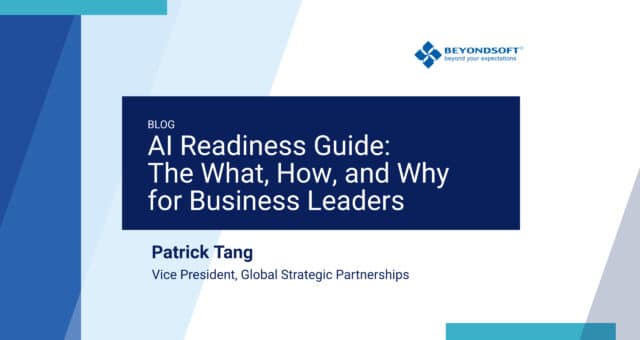Insights

AI Readiness Guide: The What, How, and Why for Business Leaders
In my recent interview with Let’s Talk Evolution, I shared practical insights from our AI readiness guide for business leaders. You can watch the video here or read the blog below.
Here’s the uncomfortable truth: AI isn’t replacing humans. It’s replacing humans who don’t work with AI.
That’s not fear mongering. I’ve spent 26 years in technology, most recently helping organizations assess their AI readiness. I’ve worked across many industries and seen it all: the good, the messy, and the “still using Excel spreadsheets to forecast demand” disasters.
Understanding AI Readiness
I’ll share my perspective on AI Readiness: Think of AI readiness like a video game with four levels. Most companies think they’re further along than they really are.
Here’s the breakdown:
Level 1: Dipping Your Toes In
You’re curious. Maybe you’ve tried ChatGPT, Claude, Perplexity, or others a few times. You’re attending webinars, reading articles, and running small pilot projects. Mostly, you’re waiting for someone to show you what’s possible.
This stage is about learning the fundamentals, knowing the terminology, and getting comfortable.
Level 2: Running Pilots
Now you’re running pilots that save precious time. We know that using AI cuts document review cycles, so employees get more time back to do thinking work or reflect on how to use their time more appropriately with AI at their disposal.
The hard part? Getting people to stop working the old way. You can’t force people to use AI; you must encourage and coach them through it.
Level 3: Making It Work
You’ve figured it out in one department; now you’re rolling out what works companywide. You have clean data, and your dashboard makes sense. Your team knows that testing and learning are part of the job now.
Here’s what I’ve observed from most companies: jamming AI into complicated processes makes everything worse. The winners simplify first, then automate.
Level 4: Living in the Future
Only a few companies make it to Level 4, and they’re the unicorns. AI isn’t a project; it’s how they work. They build their own models, sell AI services to others, and blend human creativity with AI tools so smoothly you can’t tell where one begins and ends.
Practical Steps toward AI Readiness in Three Months
Here’s my playbook:
Month 1: Get Your Leadership on Board
Not just “yeah, sure, try it” buy-in. Real championship. Because if your CEO isn’t talking about it, your team won’t take it seriously.
Pull together a cross-functional team that also involves IT, legal, HR, and other stakeholders. Decide what success looks like before you start. And here’s the key: figure out what problem you’re solving. There’s no copy-paste formula, and if you don’t lay out the right foundation, this will be a pointless exercise in which you’ll just be burning money.
Months 2-3: Clean Up Your Mess
Data cleanup isn’t sexy, and it takes months. But you can’t skip it. To put it bluntly, without clean data, any AI or automation endeavor will be “garbage in, garbage out.”
So, audit your data. Connect your systems. Tighten your security. Do the boring work that makes everything else possible.
Month 3 and Beyond: Prepare Your People
This is where most companies fail. They buy the tech, ignore the humans, then wonder why nobody’s using it.
Be honest about fear. People are afraid that AI will take their jobs and that’s normal. Talk about it. Train people properly. Show them that AI is a helper, not a replacement.
Bidirectional communication is always key. Translation: don’t just tell people what’s happening. Listen to them.
Common Mistakes in AI Readiness
Half of all companies jump into generative AI with zero preparation. Don’t follow their footsteps.
- Don’t follow the hype. Just because your competitor is doing something doesn’t mean you should.
- Don’t ignore your culture. Resistance from your team will kill your project faster than any technical problem. Listen to the boots on the ground and understand what would help them.
- Don’t start with messy data. It won’t work. Period.
- Don’t get distracted by shiny objects. Focus on your current business goals.
What About Your Job?
Many companies are considering using AI to automate routine and repetitive tasks. How are you preparing your team for the future?
From our perspective, you need three things:
Understand what AI can and can’t do
Get comfortable with the tools. Learn how to write good prompts because yes, that matters. A lazy one-sentence prompt gets you elementary results.
Get better at the stuff AI can’t do
Empathy. Creativity. Complex judgment. These are your superpowers now.
Become the AI subject matter expert in your domain
That makes you indispensable.
I use AI daily and it has improved my productivity by a huge amount. People who use AI report saving time, being more creative, and enjoying their work more.
You’re not fighting AI. You’re learning to dance with it. Even if you have two left feet.
Patrick Tang, Vice President Global Strategic Partnerships, GTM Strategies, Digital & AI Transformation
The Real Bottom Line
AI readiness isn’t about having the fanciest tools or the biggest budget. It’s about knowing what you’re trying to solve, having clean data to work with, and bringing your people along for the ride.
Start small. Pick something measurable. Learn as you go. And for the love of everything, clean up your data first.
The companies winning at AI aren’t the ones with the most resources. They’re the ones who did their homework, prepared their people, and are treating AI like the tool it is: powerful, but only if you know how to use it.
Next Steps
Are you ready to strengthen your AI readiness and use AI to improve your business workflows? Contact us and we’re ready to help you break down the key components required to start or continue your AI journey.
How other leaders are applying AI readiness in practice:
- Data Operations Assistant: https://youtu.be/47H2NhuZ15o
- Digital Employee System: https://youtu.be/j20BI9RRDHA

How we do it
Our success factors over the years are a testament to driving your return on investment. Singapore is our global head office and we have 15 regional offices around the world.

Three decades of strong IT consulting and services

Global presence across four continents

Certifications* in CMMI 5, ISO 9001, ISO 45001, and ISO 27001

>30,000 global experts

Microsoft Azure Expert MSP
ISO 9001 and 45001 (certificates issued to Beyondsoft International (Singapore) Pte Ltd). ISO 27001 (certificates issued to Beyondsoft International (Singapore) Pte Ltd, Beyondsoft (Malaysia) Sdn. Bhd., and Beyondsoft Consulting Inc., Bellevue, WA, USA)
